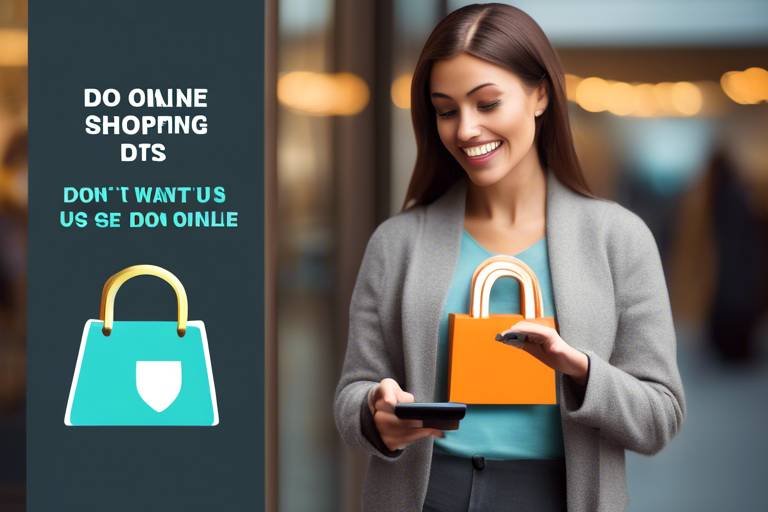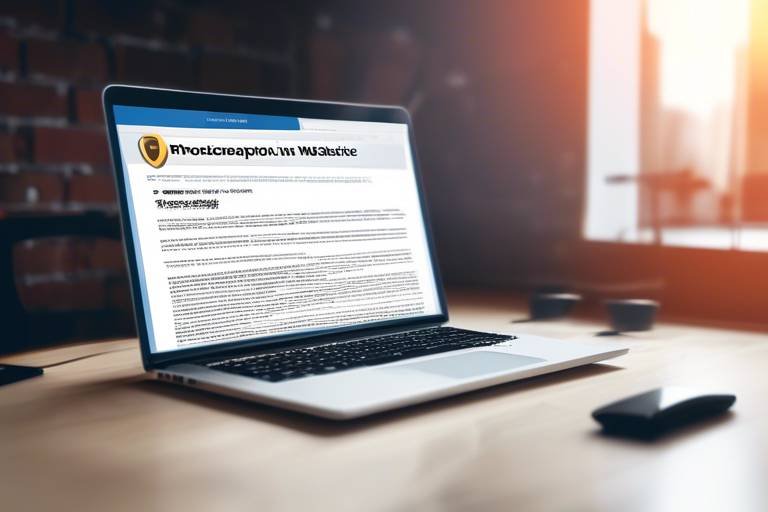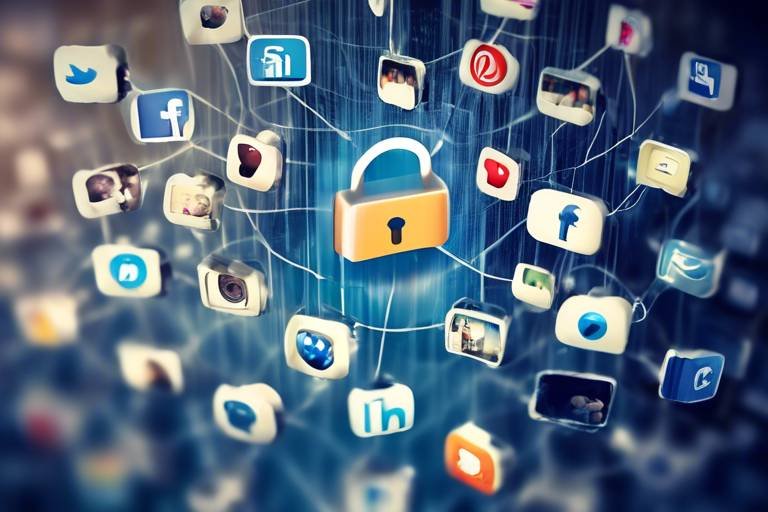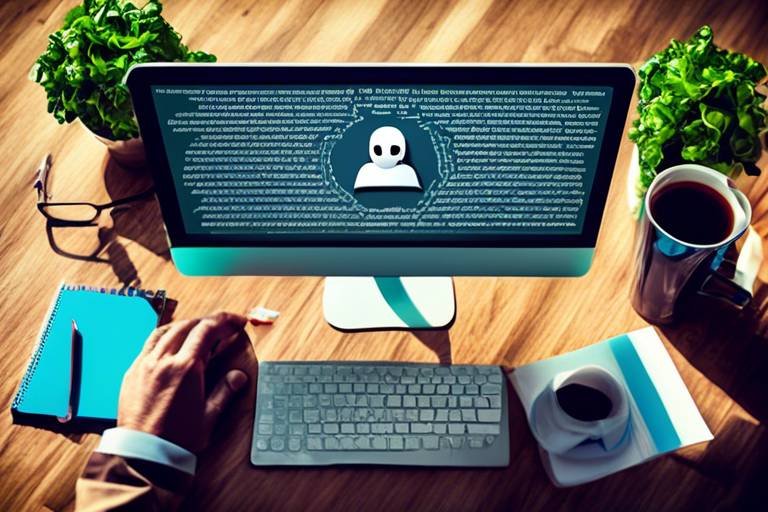Secure Online Shopping - Do's and Don'ts
In today's digital age, online shopping has become as common as picking up groceries at your local store. However, with the convenience of shopping from your couch comes the responsibility of ensuring your safety while doing so. The world of e-commerce can be a thrilling yet treacherous place, filled with potential pitfalls that could compromise your personal information and financial security. So, how can you navigate this landscape without falling prey to scams or fraud? Let’s dive into the essential do's and don'ts of secure online shopping, ensuring you have a satisfying and safe experience.
First things first: understanding online security is your first line of defense. Imagine walking through a crowded market; you wouldn’t leave your wallet wide open, right? The same principle applies online. Basic concepts like encryption and secure connections are your best friends. When you're browsing, look for URLs that start with https:// instead of just http://. The 's' stands for secure, meaning your data is encrypted during transmission. Being aware of these details is crucial for a safe shopping experience.
Next up, let's talk about choosing reputable retailers. Just like you would never buy a car from a stranger on the street, you should be cautious about where you shop online. A good rule of thumb is to stick to well-known retailers or those that have been recommended by friends or family. To identify trustworthy sites, consider checking for reviews, ratings, and certifications. A reputable site will often display security badges or certificates that show they take your safety seriously.
Now, let's delve into the world of customer reviews. These snippets of feedback can be a goldmine of information. They provide insights into a retailer's reliability and the quality of their products. But here’s the kicker: make sure to read both positive and negative reviews. A retailer with only glowing reviews may be hiding something. Balance is key; look for patterns in feedback. If multiple customers mention similar issues, it's worth taking note.
Speaking of reviews, not all of them are genuine. In fact, there’s a whole industry dedicated to creating fake reviews that can mislead you. So, how can you spot these red flags? Look for reviews that are overly vague or overly enthusiastic without any specifics. Reviews that are too generic often lack authenticity. Additionally, if a retailer has an unusually high number of five-star reviews with little to no critical feedback, proceed with caution.
When it comes to payment, always choose trusted methods. Your financial safety should be your top priority. Credit cards are generally safer than debit cards because they offer better fraud protection. Additionally, consider using payment gateways like PayPal or Apple Pay, which add an extra layer of security by acting as intermediaries between you and the retailer. By using these trusted payment methods, you're less likely to expose your financial information directly to an unknown seller.
Once you've made your purchases, the work isn’t over. Regularly monitoring your financial transactions is essential. Think of it as checking your garden for weeds; if you catch them early, they’re much easier to manage. Regularly review your bank statements and transaction history. If you notice any unauthorized charges, report them immediately. Many banks offer real-time alerts for transactions, which can help you stay on top of your spending and spot potential fraud quickly.
Now, let’s shift gears to protecting your personal information. This is paramount when shopping online. Always use strong passwords that are hard to guess. A good password is like a good lock; it should be complex and unique. Avoid using the same password across multiple sites, as this can make you vulnerable if one site gets hacked. Additionally, steer clear of public Wi-Fi when making purchases. It’s like shopping in a crowded café where anyone can peek over your shoulder. Instead, use a secure network whenever possible.
Have you heard of two-factor authentication (2FA)? It’s like having a secret handshake for your online accounts. 2FA adds an extra layer of security by requiring not just your password but also a second form of verification, like a text message code. Enabling this feature on your accounts can drastically reduce the risk of unauthorized access. Most major platforms offer this option, so be sure to take advantage of it.
Finally, let’s address the ever-present threat of phishing scams. These deceptive tactics can lure you into providing personal information under false pretenses. Be suspicious of unsolicited emails or messages that ask for sensitive information, especially if they contain links. Always verify the source before clicking on anything. Think of it as a wolf in sheep's clothing; it may look harmless, but it can cause significant damage.
Q: How can I tell if a website is secure?
A: Look for URLs that start with https:// and check for security badges or certifications on the site.
Q: What should I do if I suspect fraud?
A: Immediately report any suspicious transactions to your bank and change your passwords.
Q: Is it safe to use public Wi-Fi for shopping?
A: It’s best to avoid public Wi-Fi for online shopping. Use a secure network whenever possible.
Q: How can I protect my personal information?
A: Use strong, unique passwords and enable two-factor authentication on your accounts.

Understanding Online Security
When it comes to online shopping, understanding security is not just a nice-to-have; it's a must. Imagine stepping into a store where you can't see the exits, and every corner is shrouded in darkness. That's what shopping online can feel like without the proper security measures in place. At its core, online security revolves around a few fundamental concepts that every shopper should grasp. First and foremost is encryption. This is the process of converting information into a code to prevent unauthorized access. Think of it as sending a secret message that only you and the intended recipient can understand. Websites that use encryption will have URLs starting with https instead of http, with the "s" standing for secure. So, the next time you're about to enter your credit card information, make sure the website's URL has that all-important 's'!
Another critical aspect is recognizing secure connections. You might wonder, "How do I know if a site is secure?" Well, beyond that 's' in https, look for a small padlock icon in the address bar. This little symbol is like a bouncer at a club, ensuring only those with the right credentials can get in. If you don’t see it, think twice before proceeding. Additionally, be wary of websites that ask for excessive personal information. If a retailer is asking for your social security number or your mother's maiden name just to buy a pair of shoes, it's time to hit the brakes!
Moreover, being aware of phishing attempts is crucial. These scams are designed to trick you into providing personal information by masquerading as legitimate businesses. For example, you might receive an email that looks like it's from your favorite online store, complete with their logo and branding, asking you to verify your account. Always double-check the sender's email address and never click on suspicious links. A good rule of thumb is to type the website's URL directly into your browser instead of following links from emails.
In summary, understanding online security is like having a roadmap in a foreign city. It guides you through the potential pitfalls and helps you navigate safely. By being vigilant and recognizing the signs of secure versus insecure websites, you can enjoy your online shopping experience without the nagging fear of fraud lurking around every corner.

Choosing Reputable Retailers
When it comes to online shopping, the foundation of a safe experience lies in choosing reputable retailers. With the vast number of websites available, it can be overwhelming to determine which ones are trustworthy. But fear not! There are several strategies you can adopt to ensure that your shopping experience is both secure and satisfying. First and foremost, always look for customer reviews and ratings. A retailer with a solid reputation will usually have a plethora of reviews from previous customers. These reviews can provide you with valuable insights into the quality of products and services offered. However, it’s important to read a balanced mix of both positive and negative feedback to get a complete picture.
Another crucial aspect is to check for certifications and secure connections. Websites that prioritize security will often display trust seals or certifications from reputable organizations. Look for signs like SSL certificates, indicated by a padlock icon in the address bar. This means that the site encrypts your data, making it much harder for hackers to access your personal information. Additionally, reputable retailers will usually have a clear and comprehensive return policy and customer service options. If a website is vague about these policies, it might be a red flag.
To further assist you in identifying reputable retailers, let’s break down some essential factors to consider:
- Check the domain name: Ensure the website has a professional domain name, typically ending in .com, .org, or similar. Be cautious of unusual domain extensions.
- Look for contact information: A legitimate retailer will provide clear contact details, including a physical address and customer service phone number.
- Research their social media presence: Reputable retailers often have active social media accounts where they engage with customers and showcase their products.
- Review their online policies: Read through their privacy policy and terms of service to understand how they handle your data.
By following these guidelines, you can significantly reduce the risks associated with online shopping. Remember, taking a few extra minutes to research can save you from potential headaches down the road. So, the next time you’re about to click that “Buy Now” button, take a moment to ensure that you’re shopping with a reputable retailer. Your peace of mind is worth it!
Q: How can I verify if an online retailer is legitimate?
A: Look for customer reviews, check for secure connections (SSL certificates), and verify their contact information and return policies.
Q: What should I do if I suspect an online retailer is a scam?
A: Avoid making a purchase, report the site to consumer protection agencies, and share your experience with others.
Q: Are there specific payment methods that are safer for online shopping?
A: Yes, using credit cards or trusted payment gateways like PayPal can offer additional protection against fraud.

Reading Customer Reviews
When it comes to online shopping, customer reviews are like gold nuggets hidden in a vast digital landscape. They provide a glimpse into the experiences of others who have tread the same path before you. But why should you care about what others say? Well, reading reviews can help you make informed decisions and steer clear of potential pitfalls. Imagine you're about to buy a new gadget. Instead of just going with the flashy product description, you dive into the reviews. You might discover that the battery life is a deal-breaker or that the customer service is top-notch. This kind of insight can save you time, money, and frustration.
However, not all reviews are created equal. It's important to approach them with a discerning eye. Look for patterns in the feedback. If multiple customers mention the same issue, it's likely a legitimate concern. Conversely, if you see a flurry of overly positive reviews that all sound similar, it could be a red flag. Some companies resort to manipulating reviews to create a false sense of reliability. To help you navigate this tricky terrain, here are a few tips:
- Check the number of reviews: A product with hundreds of reviews is usually more trustworthy than one with just a handful.
- Look for detailed feedback: Genuine reviews often contain specific details about the product, while vague comments may indicate a lack of authenticity.
- Consider the timing: Be wary of a sudden influx of positive reviews, especially if they all appear around the same time. This could suggest manipulation.
Moreover, reading both positive and negative reviews is crucial. While glowing reviews can make your heart race with excitement, negative ones can offer valuable lessons. They often highlight potential issues that you may not have considered. For example, if a review warns that the product doesn't work well in certain conditions, you might think twice before making your purchase. It's all about gathering as much information as possible to make a well-rounded decision.
In conclusion, diving into customer reviews before completing your online purchase is not just a good practice; it's a smart strategy. By taking the time to read through these insights, you're arming yourself with knowledge that can lead to a more satisfying shopping experience. Remember, the more informed you are, the better choices you can make. So, the next time you’re about to hit that 'buy now' button, pause for a moment and explore what others have to say. It might just save you from a regrettable decision!
Q: How do I know if a review is genuine?
A: Look for detailed feedback and check for patterns in reviews. Be cautious of overly positive reviews that seem similar.
Q: Should I trust reviews on the retailer's website?
A: While many retailers display genuine reviews, some may filter out negative feedback. It's wise to check independent review sites as well.
Q: How many reviews should I read before making a decision?
A: Aim to read a mix of positive and negative reviews, ideally from at least 10-15 customers, to get a balanced perspective.

Identifying Fake Reviews
In the vast ocean of online shopping, customer reviews can often feel like a lighthouse guiding you to safe shores. However, not all beacons shine truthfully; some may lead you astray. Identifying fake reviews is crucial for making informed purchasing decisions and ensuring that the products you buy meet your expectations. So, how can you differentiate between genuine feedback and cleverly crafted deceptions? Here are some key indicators to look out for:
First and foremost, examine the language used in the reviews. Authentic reviews often contain a mix of emotions and detailed descriptions about the product. If a review sounds overly positive or lacks specific details, it could be a red flag. For instance, phrases like "best product ever!" or "I loved it so much!" without any elaboration can indicate a potentially fake review. Genuine reviewers usually share their experiences, mentioning specific features they liked or disliked.
Next, pay attention to the reviewer's profile. Check how many reviews they have posted. If a reviewer has only posted one or two reviews, particularly for different products from the same retailer, this could indicate a fake profile. On the other hand, a reviewer with a history of diverse feedback across various products is more likely to be a genuine customer. Additionally, look for profiles that seem to have been created recently; these can often be linked to fraudulent activity.
Another tactic employed by unscrupulous sellers is the use of similar wording across multiple reviews. If you notice a pattern where several reviews use the same phrases or structure, it's a strong indication that they may have been written by the same person or manipulated by the retailer. A quick scan through the reviews can help you spot this repetition. Moreover, consider the timing of the reviews. If a flood of overwhelmingly positive reviews appears on the same day or within a short period, it’s worth being cautious.
Ultimately, the best approach is to take a holistic view of the reviews. Instead of focusing solely on the star ratings, read a mix of both positive and negative feedback. This can provide a more balanced perspective on the product. When you see a product with a 5-star rating but a few 1-star reviews detailing specific issues, it’s essential to investigate further. Often, the negative reviews can reveal potential problems that the glowing ones gloss over.
To summarize, here are some quick tips for identifying fake reviews:
- Watch for overly positive language without details.
- Check the reviewer's history and profile authenticity.
- Look for similar wording across multiple reviews.
- Be cautious of timing—many reviews in a short period can indicate manipulation.
- Read a mix of positive and negative reviews for a balanced view.
By being vigilant and employing these strategies, you can navigate the murky waters of online reviews with confidence, steering clear of fake testimonials and making informed purchasing decisions that lead to a satisfying shopping experience.
Q: How can I tell if a review is fake?
A: Look for signs such as overly positive language, a lack of detail, suspicious reviewer profiles, and patterns in wording across multiple reviews.
Q: Are all 5-star reviews suspicious?
A: Not necessarily. However, if a product has an overwhelming number of 5-star reviews with little diversity in feedback, it’s wise to investigate further.
Q: What should I do if I suspect a review is fake?
A: Report the review to the platform and consider checking other sources for more reliable feedback.
Q: Can I trust reviews on social media?
A: While many reviews on social media can be genuine, they can also be manipulated. Always cross-check with reputable review sites.

Using Trusted Payment Methods
When it comes to online shopping, the payment method you choose can make all the difference between a secure transaction and a potential disaster. Using trusted payment methods not only safeguards your financial information but also enhances your overall shopping experience. Imagine you're walking through a bustling marketplace. Would you hand over your wallet to a stranger? Certainly not! The same caution should apply when you’re shopping online. So, what are the best options available to you?
First and foremost, credit cards are often the safest choice for online purchases. They come with built-in fraud protection features that can help you recover your money if something goes wrong. Most credit card companies offer zero liability policies, meaning that if someone makes unauthorized charges, you won’t be held responsible. This is a huge plus when you consider the risks of online shopping.
Another reliable option is using payment gateways like PayPal, Apple Pay, or Google Pay. These platforms act as intermediaries between you and the retailer, meaning you don’t have to directly share your credit card details with every website you shop from. This extra layer of security can be a game changer. By using a payment gateway, you can avoid exposing your sensitive information to potentially untrustworthy sites.
However, not all payment methods are created equal. Here are some payment methods you should avoid:
- Wire Transfers: Once you send money via wire transfer, it’s nearly impossible to get it back. Scammers often prefer this method because it’s untraceable.
- Direct Bank Transfers: Similar to wire transfers, these can leave you vulnerable. Once the money is gone, it’s gone.
- Prepaid Debit Cards: While they can be useful for budgeting, they can also be a favorite among scammers since they can be loaded and spent anonymously.
In summary, when you're shopping online, always opt for trusted payment methods that offer protection and peace of mind. It’s like choosing a reliable friend to help you carry your shopping bags instead of a stranger—you just feel safer knowing your valuables are in good hands!

Monitoring Your Transactions
In the fast-paced world of online shopping, keeping an eye on your transactions is not just a good idea—it's essential. Imagine walking into a store, filling your cart, and then forgetting to check your receipt. You wouldn’t do that in person, right? The same principle applies online. Regularly monitoring your financial transactions can help you catch any suspicious activity before it spirals out of control. It’s like having a security guard for your wallet, ensuring that every dollar spent is accounted for.
One of the first steps in monitoring your transactions is to regularly check your bank and credit card statements. This might sound tedious, but it’s crucial. You can set a routine, perhaps once a week, to review your statements. Look for any unfamiliar charges or transactions that you don’t recognize. If you spot something odd, don’t hesitate to reach out to your bank or credit card provider immediately. They can help you investigate and potentially reverse fraudulent charges.
Additionally, many banks now offer mobile apps that provide real-time transaction alerts. These notifications can be a game changer, allowing you to see each transaction as it happens. Think of it as having a personal assistant who whispers in your ear every time your card is swiped. If you receive an alert for a purchase you didn’t make, you can act swiftly to secure your account.
To further enhance your monitoring efforts, consider keeping a record of your online purchases. You can create a simple spreadsheet or use budgeting apps that allow you to categorize your spending. By doing this, you can easily track where your money is going and identify patterns that may indicate potential fraud. Here’s a quick example of how you might structure your purchase log:
| Date | Merchant | Amount | Status |
|---|---|---|---|
| 2023-10-01 | Online Store A | $50.00 | Completed |
| 2023-10-05 | Online Store B | $30.00 | Completed |
| 2023-10-07 | Online Store C | $120.00 | Pending |
By maintaining such a log, you not only become more aware of your spending habits but also create a paper trail that can be invaluable if you ever need to dispute a charge. It’s like having a financial map that guides you through your spending landscape.
Finally, don’t underestimate the power of communication. If you’re shopping with family or friends, make sure to discuss any shared expenses. This can help prevent confusion and ensure that everyone is aware of the transactions taking place. After all, transparency is key in maintaining trust and security in your financial dealings.
In summary, monitoring your transactions is a vital practice for safe online shopping. By regularly reviewing your statements, utilizing alerts, keeping a purchase log, and communicating openly with others, you can protect yourself from fraud and ensure a secure shopping experience. Remember, staying vigilant is the best defense against potential threats in the online shopping world.
- How often should I check my bank statements? It’s advisable to check your bank statements at least once a week to catch any unauthorized transactions early.
- What should I do if I find a suspicious charge? Contact your bank or credit card provider immediately to report the charge and dispute it.
- Are there tools to help me monitor my transactions? Yes, many banks offer mobile apps with real-time alerts for transactions. Additionally, budgeting apps can help you track your spending.
- What is the best way to keep track of my online purchases? Keeping a detailed log in a spreadsheet or using budgeting software can help you monitor your purchases effectively.

Protecting Personal Information
When it comes to online shopping, protecting your personal information is not just a precaution—it's a necessity. With the rise of cyber threats, safeguarding your data should be at the forefront of your mind. Imagine your personal information as a treasure chest; you wouldn't leave it unlocked in a public space, right? Similarly, you need to take steps to ensure that your data remains secure while you shop online. Here are some essential tips to help you keep your information safe:
First and foremost, using strong passwords is crucial. A strong password is like a sturdy lock on your treasure chest. It should be a mix of upper and lower case letters, numbers, and special characters. Try to avoid using easily guessable information, like your birthday or the name of your pet. Instead, consider using a password manager to generate and store complex passwords securely. This way, you can create unique passwords for different accounts without the hassle of remembering them all.
Another important aspect of protecting your personal information is to avoid public Wi-Fi when making purchases. Public networks are often less secure and can expose your data to hackers. If you absolutely must use public Wi-Fi, consider using a Virtual Private Network (VPN). A VPN encrypts your internet connection, making it much harder for anyone to snoop on your activities. Think of it as a secret tunnel that keeps your information safe from prying eyes.
Additionally, it's vital to be cautious about the information you share. Only provide the necessary details required for your purchase. For instance, if a retailer asks for your Social Security number or unnecessary personal information, it’s a red flag. Always read the privacy policy of the website to understand how your data will be used and stored. A reputable retailer will have a clear policy that outlines their commitment to protecting your information.
Furthermore, enabling two-factor authentication (2FA) on your accounts can significantly enhance your security. This feature adds an extra layer of protection by requiring not just a password but also a second form of verification, such as a text message or an authentication app code. It’s like having a second lock on your treasure chest—one that only you can access. Most online retailers and payment platforms offer this feature, so be sure to take advantage of it.
Lastly, stay vigilant against phishing attempts. Phishing scams can come in various forms, such as emails or messages pretending to be from legitimate retailers. They often urge you to click on links or provide personal information. Always double-check the sender's email address and look for signs of a scam, such as poor grammar or generic greetings. If something feels off, trust your instincts and don’t engage. Remember, it’s better to be safe than sorry!
In conclusion, protecting your personal information while shopping online is an ongoing effort that requires awareness and proactive measures. By implementing these strategies, you can enjoy a safer shopping experience, ensuring that your treasure chest remains securely locked.
- What is the best way to create a strong password? Use a mix of letters, numbers, and symbols, and avoid personal information.
- Is it safe to shop on public Wi-Fi? It's risky; use a VPN if you must shop on public networks.
- How can I tell if a website is secure? Look for "https://" in the URL and check for security certificates.
- What should I do if I suspect phishing? Do not click on links and report the email to your email provider.

Utilizing Two-Factor Authentication
When it comes to online shopping, security should be at the forefront of your mind. One of the best ways to bolster your account security is by utilizing Two-Factor Authentication (2FA). But what exactly is 2FA, and why is it so crucial for your online shopping experience? In simple terms, 2FA adds an extra layer of protection by requiring not just a password, but also something that only you have—like a code sent to your phone or an app. Think of it like a double lock on your front door; even if someone manages to pick the first lock (your password), they still can’t get in without the second key (the authentication code).
Enabling 2FA is usually straightforward. Most reputable online retailers and platforms offer this feature in their security settings. Once you enable it, you’ll typically receive a verification code via SMS or through an authentication app each time you log in. This means that even if a hacker somehow gets hold of your password, they would still need access to your phone or authentication method to gain entry to your account. It’s a simple yet effective way to keep your personal information safe from prying eyes.
Here are some tips to ensure you’re making the most of Two-Factor Authentication:
- Choose the Right Method: Some platforms allow you to choose between SMS codes, email codes, or authentication apps. While SMS is convenient, authentication apps like Google Authenticator or Authy are generally considered more secure.
- Keep Your Backup Codes Safe: Many services provide backup codes when you enable 2FA. Store these in a secure location, as they can be a lifesaver if you lose access to your primary authentication method.
- Stay Updated: Regularly check your account settings to ensure that your 2FA method is still active and that your contact information is up to date.
In conclusion, utilizing Two-Factor Authentication is a smart move for anyone who shops online. It’s like having a security guard watching over your digital transactions. By taking this extra step, you can enjoy a more secure shopping experience, knowing that your personal information is better protected against unauthorized access. So, why wait? Enable 2FA today and give yourself peace of mind while you shop from the comfort of your home!
1. What is Two-Factor Authentication?
Two-Factor Authentication (2FA) is a security process that requires two different forms of identification to access an account, typically a password and a code sent to your phone or email.
2. Why should I use Two-Factor Authentication?
Using 2FA significantly enhances your account security by adding an additional layer of protection, making it much harder for unauthorized users to access your account.
3. How do I enable Two-Factor Authentication?
You can usually enable 2FA in the security settings of your online account. Look for options like "Two-Factor Authentication" or "Two-Step Verification" and follow the prompts to set it up.
4. What should I do if I lose access to my 2FA method?
If you lose access to your authentication method, use the backup codes provided when you set up 2FA. If you don’t have those, you may need to follow the recovery process outlined by the platform.

Recognizing Phishing Attempts
In the digital age, phishing attempts are like the wolves in sheep's clothing, lurking around every corner of the internet, especially during online shopping. These scams are designed to trick you into revealing sensitive information, such as your credit card details, passwords, or social security numbers. So, how can you spot these deceitful tactics before they ensnare you? Let’s dive into some key indicators that can help you recognize phishing attempts and protect yourself while enjoying the convenience of online shopping.
First and foremost, always scrutinize the email address from which the message originates. Phishing emails often come from addresses that look similar to legitimate ones but may include slight variations. For instance, a message from “support@yourbank.com” could easily be spoofed as “support@yourbank-secure.com”. Always double-check the sender’s details before clicking on any links or providing personal information.
Next, be wary of urgent language in the message. Phishing attempts often create a false sense of urgency to pressure you into making hasty decisions. Phrases like “Your account will be suspended unless you act now!” or “Immediate action required!” should raise red flags. Legitimate companies typically do not rush their customers into providing sensitive information.
Another common tactic is the use of generic greetings. Phishing emails often start with vague salutations like “Dear Customer” instead of using your actual name. If a company you’ve dealt with before fails to address you personally, it’s likely a scam. Additionally, look out for spelling and grammatical errors, which are telltale signs of a phishing attempt. Professional organizations usually maintain high standards in their communications.
Furthermore, always hover over links before clicking. This simple action allows you to see the actual URL where the link will take you. If the link appears suspicious or does not match the legitimate website of the company, do not click it! Instead, navigate to the website directly by typing the URL into your browser or using a bookmark you’ve created.
To further enhance your defenses against phishing, consider the following tactics:
- Enable spam filters: Most email services provide options to filter out potential phishing emails. Make sure these are activated.
- Use antivirus software: Reliable antivirus programs can detect and block phishing attempts, adding an extra layer of protection.
- Educate yourself: Stay informed about the latest phishing scams. Knowledge is power, and being aware of new tactics can help you avoid falling victim.
Finally, if you ever suspect that you’ve been targeted by a phishing attempt, it’s crucial to act quickly. Change your passwords immediately and monitor your financial accounts for any unauthorized transactions. Reporting the phishing attempt to the appropriate authorities can also help protect others from falling victim to the same scam.
In conclusion, recognizing phishing attempts requires vigilance and a critical eye. By understanding the common tactics used by scammers and implementing protective measures, you can shop online with confidence, knowing that you’re safeguarding your personal information against these deceitful predators.
Q: What should I do if I think I received a phishing email?
A: If you suspect an email is a phishing attempt, do not click any links or provide any personal information. Report it to your email provider and delete it.
Q: Can phishing attempts happen on social media?
A: Absolutely! Phishing can occur on social media platforms through messages or posts that appear to be from legitimate accounts. Always verify the source before engaging.
Q: What are some signs that a website is secure?
A: Look for URLs that begin with "https://" and a padlock icon in the address bar. These indicate that the website uses encryption to protect your data.
Q: How can I protect my passwords from phishing?
A: Use strong, unique passwords for each account and consider using a password manager to keep track of them. Enabling two-factor authentication adds an extra layer of security.
Frequently Asked Questions
- What is online security and why is it important?
Online security refers to the measures taken to protect your personal information while shopping or browsing online. It's crucial because it helps prevent identity theft, fraud, and unauthorized access to your sensitive data. Think of it as a digital lock on your door—without it, anyone could just waltz in!
- How can I identify a reputable online retailer?
To spot a trustworthy online retailer, look for customer reviews, check their ratings on third-party sites, and verify if they have proper certifications. If a site looks sketchy or has too many red flags, it's better to shop elsewhere. Remember, a little research can save you a lot of headaches later!
- What should I do if I suspect a review is fake?
If you think a review might be fake, look for signs like overly generic language, repeated phrases, or a lack of detail. Genuine reviews usually provide specific experiences, while fake ones often sound like they were written by a robot. Trust your gut—if something feels off, it probably is!
- What are the safest payment methods for online shopping?
The safest payment methods include credit cards and trusted payment gateways like PayPal. These options often come with fraud protection and can help you dispute unauthorized charges. Think of them as your financial bodyguards—keeping your money safe while you shop!
- How can I monitor my transactions effectively?
Regularly checking your bank statements and transaction history is key to spotting any unauthorized charges. Set up alerts for transactions over a certain amount, and don't hesitate to report anything suspicious. It's like keeping an eye on your wallet—better to be safe than sorry!
- What steps can I take to protect my personal information?
To safeguard your personal data, use strong, unique passwords for each account, enable two-factor authentication, and avoid using public Wi-Fi for shopping. These practices act like a security blanket, wrapping your information in layers of protection against prying eyes.
- What is two-factor authentication and how does it work?
Two-factor authentication (2FA) adds an extra step to your login process, requiring not just your password but also a second form of verification, like a text message code. It's like having a bouncer at your digital door—only those with the right credentials can get in!
- How can I recognize phishing attempts?
Phishing attempts often come in the form of emails or messages that look legitimate but are trying to trick you into giving away personal information. Look for spelling errors, generic greetings, and suspicious links. If it smells fishy, it's probably a phishing scam!



















